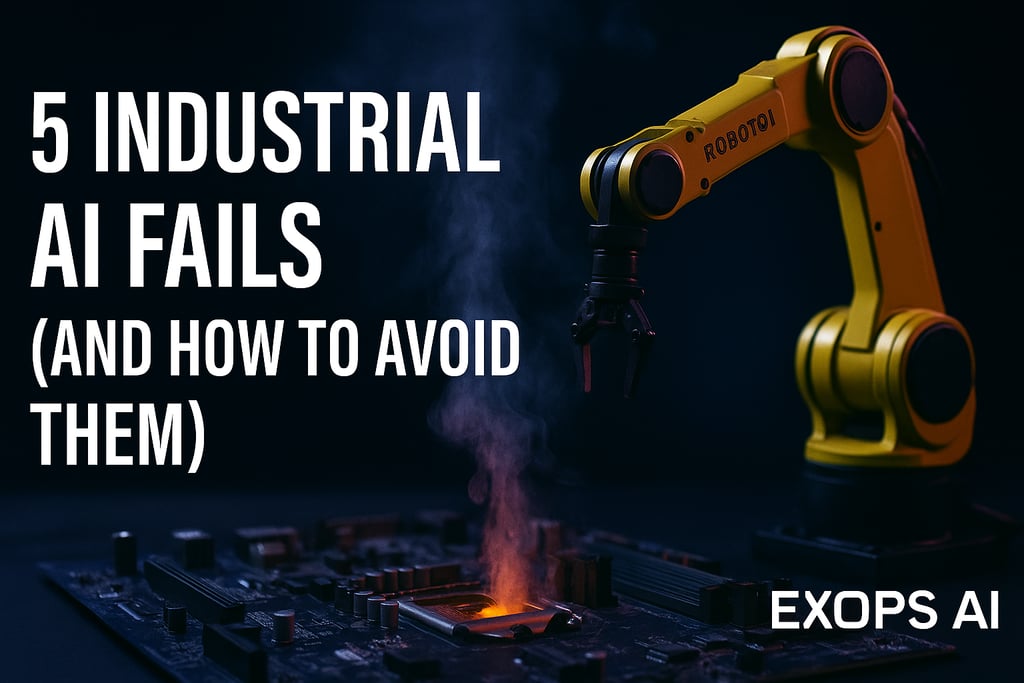
5 Industrial AI Fails (and How to Avoid Them)
Generative AI is revolutionizing industrial workflows—but it’s not foolproof. In this post, we unpack five real-world failures from AI pilots in high-risk environments, including hallucinated safety standards, compliance blind spots, and over-customized models that broke overnight. Learn what went wrong, why it happened, and how EXOPS AI avoids these traps with expert-level prompt engineering and domain-trained GPTs.
USE OF GENERATIVE AI
EXOPS AI
7/13/20252 min read



My post content
Generative AI holds immense promise, but missteps can lead to catastrophic errors, wasted API credits, or outright hallucinations. In this post, we expose five real-world “AI fails” we’ve encountered in industrial pilots and share battle-tested tactics from EXOPS AI to keep your projects on track.
1. The Wild Hallucination
What Happened: The GPT invented a non-existent safety standard, citing “ISO 1234” when asked about BOP procedures.
Lesson Learned: Always ground your GPT in verifiable facts.
Fix: Preload certified regulation text via system prompts and use “citation mode” to force the model to quote sources.
2. Prompt Overload
What Happened: A single prompt with 5,000 words of mixed data caused timeouts and nonsensical summaries.
Lesson Learned: GPTs work best with modular prompts.
Fix: Break large datasets into smaller chunks and iteratively summarize. Use a “chain-of-thought” prompting pattern to maintain coherence.
3. Compliance Blindspot
What Happened: GPT skipped over mandatory audit steps, leading to an incomplete checklist and near-missed fines.
Lesson Learned: You must bake compliance rules into the prompt itself.
Fix: Embed “must-check” bullet points at the top of every prompt: “Always verify X, Y, Z per regulatory guideline ABC before proceeding.”
4. Context Drift
What Happened: After 40 chat turns, the model forgot earlier input parameters, leading to inconsistent recommendations.
Lesson Learned: Session memory isn’t infinite.
Fix: Periodically summarize the conversation and re-inject key variables, or chain calls with external context storage.
5. Over-Customization
What Happened: Over-fine-tuning on a small proprietary dataset produced brittle models that broke when OpenAI updated GPT-4.
Lesson Learned: Heavy fine-tuning can lock you out of future improvements.
Fix: Lean on prompt engineering and light-touch parameter tweaks; preserve the underlying GPT-4 foundation so you inherit ongoing model upgrades.
Conclusion & Next Steps
By understanding these common pitfalls—and applying our prompt-engineering best practices—you can harness generative AI with confidence. Ready to skip the fails and jump straight to impact? Browse our vetted, domain-tuned GPTs on the EXOPS AI Store or schedule a one-on-one deep dive with our team.
Disclaimer
The examples in this post are for illustrative purposes only and do not constitute regulatory, legal, or safety advice. Always consult industry experts before applying AI in critical operations.
Author: EXOPS AI L.L.C.
Connect with us: info@exopsai.io | +1 (833) 396-7724
Explore our Custom GPT Store: https://exopsai.io/artificial-intelligence-gpt-store

